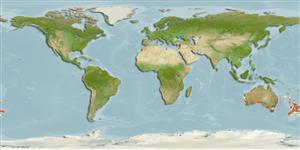分類 / Names
俗名 | 同種異名 | Catalog of Fishes(屬, 種) | ITIS | CoL | WoRMS | Cloffa
Teleostei >
Scombriformes (Mackerels)
鱸形目 (Mackerels) >
Gempylidae (Snake mackerels)
蛇鯖科 (Snake mackerels)
Etymology: Rexea: Latin, rex, rego = king.
Eponymy: Daniel Carl [Karl] Solander (1733–1782) was a Swedish naturalist and explorer who was one of Linnaeus’s pupils at Uppsala. [...] (Ref. 128868), visit book page.
More on author: Cuvier.
Environment: milieu / climate zone / depth range / distribution range
生態學
海洋 底中水層性; 海洋洄游的 (Ref. 51243); 深度上下限 100 - 800 m (Ref. 6181), usually 300 - 450 m (Ref. 28786). 深水域; 25°S - 48°S, 109°E - 173°W (Ref. 6181)
Southwest Pacific: off southern, southwestern and southeastern Australia, Tasmania and New Zealand. Occurrence records from Madagascar and Japan need to be verified.
西南太平洋: 外海的南方, 澳洲東南部與西南部,塔斯梅尼亞與紐西蘭。 發生來自馬達加斯加與日本需要的紀錄被查證。
Length at first maturity / 大小 / 重量 / 年齡
Maturity: Lm 65.0, range 60 - 70 cm
Max length : 110 cm SL 雄魚/尚未辨別雌雄; (Ref. 6181); 最大體重: 16.0 kg (Ref. 28838); 最大年齡: 16 年 (Ref. 28786)
背棘 (總數) : 18 - 19; 背的軟條 (總數) : 16 - 19; 臀棘: 2; 臀鰭軟條: 13 - 16; 脊椎骨: 36. Body entirely scaled at over 25 cm SL. Lateral line branching below the 5th to the 6th spine of the first dorsal fin. The upper branch reaches beyond the origin of the second dorsal fin, usually ending between the 8th to the 12th soft ray. The lower branch runs mid laterally, undulating above the anal-fin base. Body is bluish above, silvery below, a black blotch distally on two anterior membranes of the first dorsal fin, the rest of the fin is grayish.
身體完全地在超過 25 公分 SL 覆有鱗片的。 側線在第 5個到第一背鰭的第 6 棘下分枝。 上面的分支達到超過第二個背鰭的起源, 通常在第 8個到第 12個柔軟鰭條之間結束。 下面的分支側面中央地跑, 波動在臀鰭基底上面。 身體是藍色的上方, 下面銀色的, 一個黑色的斑塊末梢部地在二個前面第一背鰭的薄膜上, 其它的鰭是淺灰色的。
Found in schools on continental shelf and slope. They are normally caught close to the sea bed but probably move into midwater at times (Ref. 28786). Juveniles are pelagic, adults also occur near the surface off Tasmania and New Zealand. Dense schools of pre-spawners migrate along the continental slope at about 400 m during winter (Ref. 9563). Feed on fish, squid and crustaceans. The flesh is of good edible quality and especially tasty when smoked. In Australia, the eastern gemfish stock has been subjected to a prolonged period of poor recruitment which started in 1989 (Ref. 28843, 28786). This event resulted in a very significant decline in the gemfish resource. In Australia, efforts are now being channeled towards the recovery of the fishery.
成群出現在大陸棚及大陸坡上。 他們通常被捕捉接近海床但是偶而可能移進中層水域中.(參考文獻 28786) 稚魚是大洋性的, 成魚也出現接近水表面外海的塔斯梅尼亞與紐西蘭。 產卵前的魚的密集魚群移動在冬天期間於大約 400 公尺沿著大陸斜坡.(參考文獻 9563) 捕食魚,烏賊與甲殼動物。 肉是有好可食用的品質與尤其好吃的當煙燻時的。 在澳洲,東方的帶鰆魚分枝已經被受在 1989 年開始的一個少量入添的被延長的時期支配。 (參考文獻 28843,28786) 這一個事件造成了帶鰆魚資源的一個非常重要的減少。 在澳洲,努力現在正在被導向漁場的恢復。
Life cycle and mating behavior
成熟度 | 繁殖 | 產卵場 | 卵 | 孕卵數 | 仔魚
Larvae are caught in inshore waters which may indicate that gemfish move onto the shelf to spawn, or currents carry larvae in from offshore spawning grounds (Ref. 28786).西南太平洋: 外海的南方, 澳洲東南部與西南部,塔斯梅尼亞與紐西蘭。 發生來自馬達加斯加與日本需要的紀錄被查證。
Nakamura, I. and N.V. Parin, 1993. FAO Species Catalogue. Vol. 15. Snake mackerels and cutlassfishes of the world (families Gempylidae and Trichiuridae). An annotated and illustrated catalogue of the snake mackerels, snoeks, escolars, gemfishes, sackfishes, domine, oilfish, cutlassfishes,. scabbardfishes, hairtails, and frostfishes known to date. FAO Fish. Synop. 125(15):136 p. (Ref. 6181)
IUCN 瀕危狀態 (Ref. 130435: Version 2024-1)
人類使用
漁業: 商業性
工具
特別的報告
下載 XML
網路資源
Estimates based on models
Preferred temperature (Ref.
123201): 8.4 - 13.6, mean 10.4 °C (based on 52 cells).
Phylogenetic diversity index (Ref.
82804): PD
50 = 0.5078 [Uniqueness, from 0.5 = low to 2.0 = high].
Bayesian length-weight: a=0.00347 (0.00191 - 0.00629), b=3.13 (2.96 - 3.30), in cm total length, based on LWR estimates for this species & (Sub)family-body (Ref.
93245).
營養階層 (Ref.
69278): 4.3 ±0.66 se; based on food items.
Generation time: 5.4 (4.5 - 6.6) years. Estimated as median ln(3)/K based on 14
growth studies.
回復力 (Ref.
120179): 中等的, 族群倍增時間最少 1.4 - 4.4年 (K=0.15-0.21; tm=3-6; tmax=16; Fec=500,000).
Prior r = 0.43, 95% CL = 0.28 - 0.64, Based on 2 full stock assessments.
Fishing Vulnerability (Ref.
59153): High vulnerability (58 of 100).
Climate Vulnerability (Ref.
125649): High to very high vulnerability (65 of 100).
Nutrients (Ref.
124155): Calcium = 11 [4, 29] mg/100g; Iron = 0.306 [0.113, 0.902] mg/100g; Protein = 15.6 [13.2, 18.3] %; Omega3 = 0.228 [0.114, 0.465] g/100g; Selenium = 25.8 [10.5, 61.4] μg/100g; VitaminA = 15.4 [3.4, 72.8] μg/100g; Zinc = 0.291 [0.195, 0.444] mg/100g (wet weight); based on
nutrient studies.
